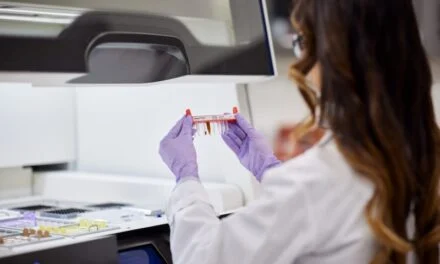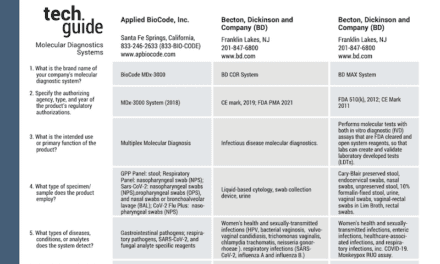Microbial culture had a role to play in diagnostics, but it’s time that molecular diagnostics is thrust fully to the forefront.
By Manoj Gandhi, MD, PhD
The COVID-19 pandemic brought with it an incredible number of changes to how the health care system operates. Diagnostics, especially molecular diagnostics (MDx),including technologies like polymerase chain reaction (PCR), accelerated dramatically as the industry raced to develop fast, efficient, and accurate tests.1 During the onset of the global pandemic, there was an urgent need to meet the incredible volume of population-wide testing as individuals scrambled to find out if they were infected, to be allowed to work, travel, attend school, and participate in other activities.
Microbial culture has long been held as the standard of care in the diagnosis of infectious diseases. The pandemic, however, accelerated the adoption of molecular diagnostics in labs around the world and has shown the power of MDx, providing an opportunity to demonstrate its marked benefits over culture and other standard microbiological techniques. Now that we have made tremendous progress in diagnostics, these advancements should remain top of mind as we transition to an endemic state. No longer is differential access a valid excuse for the delay in adoption of MDx; it’s time for a strong shift towards broad adoption of these technologies.
Advantages of Molecular Diagnostics
MDx provide considerable advantages over culture, starting with increased speed and accuracy.2 Culture takes longer, requires more hands-on time from laboratorians,3 and it can be a struggle to grow a considerable number of clinically relevant microorganisms (referred to as fastidious microorganisms or difficult-to-culture microorganisms). Lab technicians are always short on time, and more overworked than ever4, and any sort of assistance should be welcomed with open arms.
Beyond just increased accuracy and turnaround times, molecular diagnostics also offer the ability to run panels that can simultaneously analyze a myriad of pathogens from a single sample, saving critical resources and time.5 Certain diseases can have overlapping symptoms with others, such as sexually transmitted infections (STIs) or respiratory diseases, and MDx can sort through the question marks at once. Gonorrhea and chlamydia, for instance, can both have overlapping symptoms such as burning during urination, rectal pain, and more.6 With culture, multiple samples would be needed to assess such a patient to get a singular answer, whereas MDx can be used to test for both diseases, and other STIs, all at once. In fact, PCR is recommended for diagnosing, or even screening, such patients and has been shown to be cost-effective in preventing sequelae due to these infections.7 Having quick, clear answers can help ensure that proper treatment is received as soon as possible, and therapeutics aren’t wasted guessing what will work.
In addition, MDx can extend its value beyond its direct impact to diagnosis and patient management. Researchers can utilize the technology to detect variants to see how a virus is changing due to mutations8, which can inform clinicians and public health experts the extent to which the effectiveness of therapeutics are impacted or if additional countermeasures need to be put in place. The final frontier would be if molecular diagnostics can also be used for pharmacogenetics; to better inform what treatment may work best with an individual. Pharmacogenetics allow clinicians to tailor patient treatment based on the individual genetic makeup thereby safeguarding both individuals and populations from costly and harmful adverse medication reactions.9 In short, MDx provides an adaptability that is not provided by culture.
….Then, What’s Holding Molecular Diagnostics Back?
With the aforementioned clinical benefits, it seems obvious to weave MDx into the diagnostic workup for infectious diseases. In fact, many infectious disease testing laboratories have already implemented molecular diagnostics testing in their routine practice. In recent years, laboratorians have built syndromic panels for polymicrobial indications such as respiratory tract infections, gastrointestinal tract infections, and urinary tract infections, among others, that appeal a lot to the treating physicians. However, in response to the widespread adoption, payors are now taking a step back and evaluating the cost-benefit ratio, clinical validation, and clinical utility of MDx in infectious diseases, especially for the syndromic panels.
In April 2022, the Centers for Medicare & Medicaid Services (CMS) instituted a significant change that outlined guidelines for the optimal utilization of molecular diagnostics in infectious diseases. While there was no impact to the coverage for small panels (≤5 targets) or for in-patients, there were limitations imposed on the coverage for expanded/syndromic panels (≥6 targets) in the outpatient setting.10 As a result of this change, payors halted or significantly decreased the use case and reimbursement for MDx panels for infectious diseases. There is also lack of clarity on the technical assessment (TA) process, which has requirements for analytical validity (AV), clinical validity (CV), and, especially, clinical utility (CU) which is a mandatory requirement for expanded panels.
It has been theorized that these limitations have been imposed in part for cost-saving reasons, but policymakers argue that the limitation on coverage is due to lack of “peer-reviewed published evidence” about the usefulness of molecular diagnostics in the outpatient infectious disease setting. As a result, the manufacturer (which in the laboratory-developed test market is the laboratory), is now responsible for proving CU to obtain reimbursement. Regardless of the reasoning behind the limitations, this puts the huge burden of proof of generating this evidence on the manufacturer/laboratory, who may not have the medical expertise to define standard of care or to argue CU of tests that are routinely ordered by the clinician. In addition, the cost associated with generating this evidence is being transferred to the laboratories who, by themselves, often would not be able to shoulder the cost for generating such evidence.
Next Steps
Recent challenges with molecular syndromic panels regarding infectious disease are strikingly similar to those we have seen in the past with both oncology and pharmacogenomics (PGx), which have had policy updates to approach molecular diagnostics trends in present day. But just because we took the same road with oncology and PGx doesn’t mean that we need necessarily follow the same formula for infectious diseases. Policymakers and payors require a better understanding of the current diagnostic tools that clinicians and laboratorians are relying on to provide the quickest and most accurate answers to effectively treat their patients. The tools are critical to help determine treatment and improve the patient’s quality of life. Unfortunately, the current reimbursement landscape for MDx in infectious diseases within the US is limiting access to tools that support the quality of care a clinician can provide to their patients, especially the elderly (>65 yrs) who are significant risk of complications from an innocuous infection and, ironically, is the same population that is served by their payor, CMS.
The acceptance of MDx for infectious diseases was accelerated and accepted as a household term by the COVID-19 pandemic. The spotlight on molecular diagnostics has bridged the gap in technology accessibility in labs around the world. In fact, recent health crises like the outbreak of Mpox has shown that the need to move the needle forward is pressing, more now than ever. The field should continue to move forward; limiting the accessibility of MDx in infectious diseases will reverse the incredible progress made in the past few years. Clinicians, laboratorians, researchers, professional associations, and test manufacturers need to showcase the immense positive impact that molecular diagnostics can have on patients in the clinic, and this research needs to be published to show the evidence that is being demanded by the payors. All these stakeholders have equal skin in the game and need to collaborate, develop shared guidelines, and more, to advance this common goal. Once the value is even more clearly demonstrated, payors will be compelled to acknowledge the benefits of MDx in infectious diseases.
We need to make sure that we aren’t sticking with an imperfect archaic method of culture at the expense of innovation, speed and accuracy of MDx. Now policy makers and other key stakeholders can allow access to more accurate, powerful, and faster tests, providing better overall quality care to patients across disease states. We should be making it easier in getting these powerful tests in the hands of the clinicians and laboratories rather than making it harder for them to access. Culture had a role to play in diagnostics, but it’s time that molecular diagnostics is thrust fully to the forefront.
About the Author
Manoj Gandhi, MD, PhD, is the senior medical director for the genetic testing solutions business at Thermo Fisher Scientific, and is part of the team that provides medical strategy, medical and scientific oversight for product development, on-market product support, and customer engagement.
References
1 https://www.scientificamerican.com/article/the-pandemic-set-off-a-boom-in-diagnostics/
2 https://www.ncbi.nlm.nih.gov/pmc/articles/PMC3317672/
4 https://pubmed.ncbi.nlm.nih.gov/32080719/
5 https://asm.org/Guideline/Clinical-Utility-of-Multiplex-Tests-for-Respirator
6https://www.healthline.com/health/sexually-transmitted-diseases/chlamydia-vs-gonorrhea#treatment
7 https://www.cdc.gov/mmwr/preview/mmwrhtml/rr6302a1.htm
8 https://www.ncbi.nlm.nih.gov/pmc/articles/PMC9006405/




